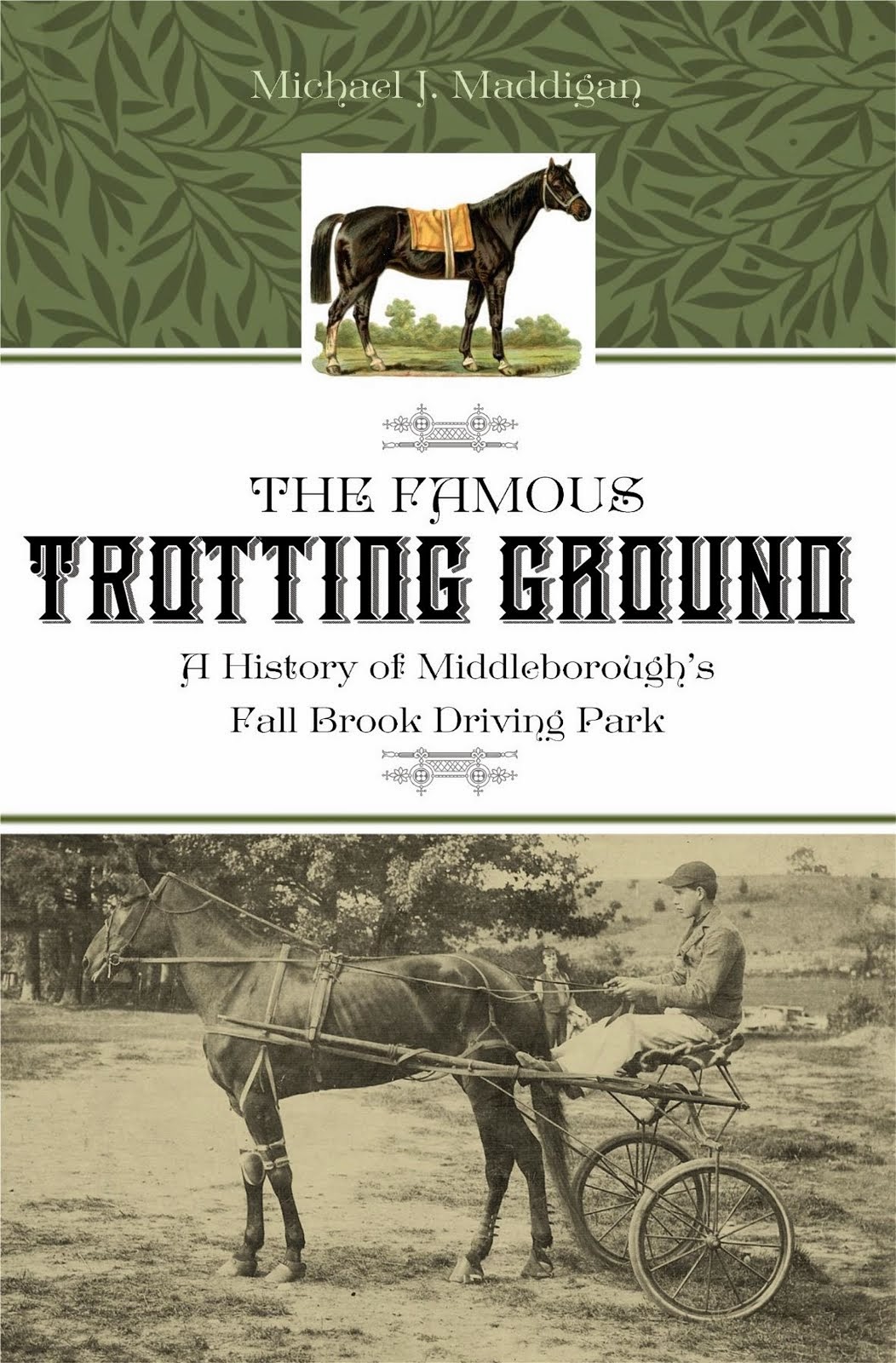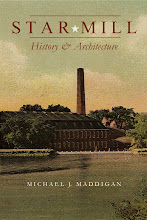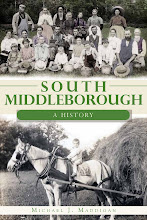Sunday, March 17, 2019
Russell's Cabins, 1950
During the period between the 1930s and 1950s, before motels
became popular, tourists passing through Middleborough were provided
accommodation in overnight camps and tourists cabins, many of which lined Route
28 from North to South Middleborough. Among them was Russell’s Grove Cabins
which stood on the now vacant parcel opposite Lorenzo’s, later the site of Rae’s
Colonial Gift Shop.
The property, a former woodlot owned by Levi O. Atwood of
Rock, was acquired in May 1934 by Durell and Gladys J. Russell who eventually transformed
it into a delightful roadside grove intended to lure tourists to stay for the
night in a cabin set among the trees. In addition to the cabins, the Russells
also conducted a small restaurant as part of the operation.
Tourists of the era were less demanding than today and the
cabins afforded a simple, affordable and pleasant solution for travellers’
needs a indicated by one postcard sent by Helen in July 1950 to her friend,
Mrs. Mattie Quinn at Hudson Falls, New York.
“Sunday night, Dear Mattie and All, These are the cabins we
are staying at tonight. We drove 233 miles today. Have double beds. Have bed
all to myself. We just had a wonderful dinner and are now out on the enclosed
porch. X marks our cabin. We made wonderful time. We are only about 80 miles to
drive tomorrow. Love to you all. Helen.”
In April 1956, the Russells sold the cabins and retired to
Florida.
Saturday, March 3, 2018
Otis Briggs House (1876)
 |
| The gable of the Otis Briggs House (1876) is visible behind the later addition that long housed Steve's Sports Den. |
Mrs. Erpell died about 1863 at which time the property passed through her will to Lydia R. Thompson of
Miller lived in the house only a short time, before disposing of it on June 3, 1872, to Salome K. Coombs of Lakeville, wife of James M. Coombs, editor of the Middleboro Gazette. At the time of the sale, in addition to the house, another building (in all likelihood a barn) was standing on the property and was included in the conveyance. The Coombses lived there briefly before relocating to a more prestigious address on
 |
| Briggs Stable Token |
Briggs had since the age of eighteen been “prominently identified with the horse business”, first at
Many of Briggs’ horses were acquired in
Briggs’ business trips were the frequent subject of news items carried in the local papers, and the horses procured in Vermont were eagerly awaited. “Otis Briggs, one of our larger dealer in horses, harnesses, carriages, etc., and who always has a good turnout for one who desires a pleasant drive, is now in
The outstanding quality of Briggs’ selections was reflected throughout the era in the prices for which his horses ultimately sold and Briggs was believed to have “handled more high priced horses than any other man in New England.” In July, 1877, Briggs received ten horses, six of which he sold within two days and one of which was valued at $1,000. Many of the horses traded were Morgans, a breed particularly admired by Briggs who brought them from
A year after acquiring the Erpell property, Briggs, in 1876, entirely refurbished the estate. In the spring of that year, Briggs purchased the 30 by 50 foot so-called “old part” of the barn of James E. Peirce on
Also at this time, Briggs constructed a new house upon the property. The Middleboro Gazette noted in October, 1876, that “Otis Briggs has begun in earnest upon his residence, on the Erpelle estate”, and another notice the following month mentions “parties now building the dwelling house for Otis Briggs.” The design of the house including its relatively high foundation wall (which would have intentionally raised the house above the mud and muck of the stable yard) support this date. Still later that year, in November, Briggs engaged James F. Eldridge to sink a well on the property. Undoubtedly, the changes were financed by Briggs’ lucrative trade and are reflective of those affordable by a relatively well-to-do businessman.
Eventually, Briggs moved into other areas of business, most likely recognizing just what the arrival of the automobile portended for his livery business. In 1906, Briggs acquired the large three-story
 |
| Staircase, Otis Briggs House (1876) |
In 1947, the property which then included the Briggs House and the market building which stood in front of it, the former School Street School, the former Briggs stable (which had been moved) and a warehouse/garage which stood (and remains) at the rear of the property, was acquired from Johnson by antique and used furniture dealers Thomas B. Nichols and C. Ernest Aubrey who demolished the former stable. The antique business of Nichols and Aubrey occupied the premises during the 1940s and early 1950s when they were succeeded by the
Monday, February 12, 2018
Woolworth's
The F. W. Woolworth Company (Woolworth’s) first came to Middleborough in 1911, establishing a store in the American Building on South Main Street as Middleborough’s first chain department store. Increasing business prompted the company to have a building built to its own specifications on Center Street in 1927-28 (the building most recently occupied by Reedy's Archery), replacing the James Soule House which had originally stood on the site. This new building was built the same year that Woolworth’s principal Middleborough competitor W. T. Grant arrived in town.
The building was purpose built for Woolworth's to that company's specifications by Arthur Shactman of Brookline, the owner of the property in 1927-28. Woolworth's proposed leasing the building for a period of 20 years commencing May 1, 1928 and ending May 1, 1948, with an annual rent of $3,600 for the first 10 years and $3,900 for the remaining years. In return, Woolworth's required the building to be "the same in workmanship and materials as the premises now occupied by the lessee at 297-297A Harvard Street, Brookline, Massachusetts." Specifications for the building were incorporated directly into the lease between Shactman and Woolworth's.
Woolworth’s occupied the southern store in the multi-store building. (The northern store in the block was occupied initially by the Park Cafe). In 1948, Woolworth's expanded to occupy the entire building and remodelled thoroughly in 1957.
Woolworth's closed its Middleborough store on December 24, 1971.
Woolworth's closed its Middleborough store on December 24, 1971.
Tuesday, February 6, 2018
Winter Scene, c. 1923
A 1920s blizzard has tied up hapless motorists on South Main Street. The sole landmark recognizable today is the Central Congregational Church, the steeple of which can be seen plastered with snow. The buildings on the left have all since been replaced by what is now the Rockland Trust Company. At the time the building at the far left housed Williams' Specialty Shop, a business conducted by Harold Williams (later of Williams' Trading Post). The view is looking from the Four Corners.
Saturday, January 27, 2018
First Holy Communion, Sacred Heart Church, 1890s
The original Sacred Heart Church was built in 1881 following Archbishop John Joseph Williams' blessing of the cornerstone on July 12, 1881. The church stood on Center Street approximately on the site today occupied by the church rectory and parking lot.
Prior to the construction of the church, the community's Catholic residents worshipped in private homes as well as the upper floor of the P. H. Peirce grocery store (now the Middleborough Police Station). Mass was celebrated by visiting priests and the first recorded Mass in Middleborough was celebrated in the home of Patrick Sullivan on Wareham Street in 1852.
Here a group of children celebrating their first Holy Communion have gathered for the photographer. The girls are attired in white dresses, veils and gloves while the boys wear their best suits. Several proud parents look on.
Though the image is undated, it appears to be from the 1890s.
Friday, January 26, 2018
B. F. Tripp Trade Cards
Trade cards were a popular means of advertising during the late 1800s. Small and highly-colored, these illustrated cards became widespread with the introduction of color lithography in the 1870s and their free distribution helped retailers and manufacturers advertise their goods. The cards were frequently changed by merchants, helping entice shoppers back for a return visit. Children often collected the cards, pasting them into bound volumes, and they remain highly collectible today.
One Middleborough merchant who made wide use of trade cards for advertising was Benjamin F. Tripp, who conducted a combined ice cream, confectionary, fruit and cigar store on the site now occupied by Kramer Park next to the former Savings Bank Building on Center Street. Tripp utilized many different styles of cards which would have been purchased in bulk and printed by a local printer (most often Thatcher & Company) with Tripp's specific information.
The samples below from the collection of Recollecting Nemasket provide a glimpse of the variety of trade cards offered by Tripp's.
Sunday, December 3, 2017
Nemasket Spring Water Company Drivers
In order to deliver its products, the Nemasket Spring Water Company required several drivers. From left to right are Sulo Jussila, Albert Malefant, George Chilian, Edmund Rondelli, Stan Sinoski and Armen Kayajan. With business reaching a new peak n 1937, the plant began 24-hour operation, requiring a fleet of 10 trucks to deliver its product throughout southern Massachusetts.
Subscribe to:
Posts (Atom)











































+of+Smoky+Mountains+018.jpg)